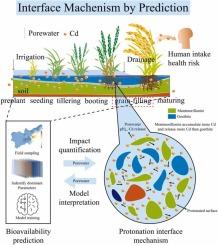Interface mechanism of Cd bioavailability by porewater prediction in paddy field system
IF 11.3
1区 环境科学与生态学
Q1 ENGINEERING, ENVIRONMENTAL
引用次数: 0
Abstract
Cadmium (Cd) contamination poses a significant threat to human health. Predicting the risk of Cd in rice grains is challenging due to the heterogeneity and complexity of bioavailable Cd in paddy soils. We proposed that porewater during the grain-filling period can effectively predict Cd bioavailability in rice (R2 > 0.5, p < 0.05). The prediction mechanism was elucidated through soil-porewater interface characterization analysis and DFT calculations. Key factors determining Cd bioavailability included Cd2+ and SO42− concentration, pH, and ORP of porewater, with pH showing the highest correlation. As porewater pH increased from 5 to 9, typical mineral surfaces gradually deprotonated and formed complexation bonds {![]() SOCd+} instead of {
SOCd+} instead of {![]() SOH} or {
SOH} or {![]() SOH2+}. Additionally, the complexation energy between montmorillonite and Cd was 1.57–1.78 eV higher than that between goethite and Cd, while the protonation activation energy barrier on montmorillonite was 1.33–1.52 eV lower than on goethite. Therefore, {H+} concentration in porewater had the potential to quantify {
SOH2+}. Additionally, the complexation energy between montmorillonite and Cd was 1.57–1.78 eV higher than that between goethite and Cd, while the protonation activation energy barrier on montmorillonite was 1.33–1.52 eV lower than on goethite. Therefore, {H+} concentration in porewater had the potential to quantify {![]() SOCd+} content and binding capacity, aiding Cd bioavailability prediction. This study outlines the mechanism of predicting heavy metal health risks in rice grains through porewater and offers a potential regulation approach for agricultural product safety.
SOCd+} content and binding capacity, aiding Cd bioavailability prediction. This study outlines the mechanism of predicting heavy metal health risks in rice grains through porewater and offers a potential regulation approach for agricultural product safety.

水稻田系统孔隙水预测镉生物利用率的界面机制
镉(Cd)污染对人类健康构成重大威胁。由于稻田土壤中可生物利用的镉的异质性和复杂性,预测稻谷中镉的风险具有挑战性。我们提出,谷物灌浆期的孔隙水可以有效预测水稻中镉的生物利用率(R2 > 0.5, p < 0.05)。通过土壤-孔隙水界面表征分析和 DFT 计算,阐明了预测机理。决定镉生物利用率的关键因素包括孔隙水的 Cd2+ 和 SO42- 浓度、pH 值和 ORP,其中 pH 值的相关性最高。随着孔隙水 pH 值从 5 升至 9,典型的矿物表面逐渐去质子化并形成络合键 {SOCd+},而不是 {SOH} 或 {SOH2+}。此外,蒙脱石与镉的络合能比鹅卵石与镉的络合能高出 1.57-1.78 eV,而蒙脱石上的质子化活化能势垒比鹅卵石上的质子化活化能势垒低 1.33-1.52 eV。因此,孔隙水中的{H+}浓度有可能量化{SOCd+}的含量和结合能力,从而帮助预测镉的生物利用率。本研究概述了通过孔隙水预测稻谷中重金属健康风险的机制,为农产品安全提供了一种潜在的监管方法。
本文章由计算机程序翻译,如有差异,请以英文原文为准。
求助全文
约1分钟内获得全文
求助全文
来源期刊

Journal of Hazardous Materials
工程技术-工程:环境
CiteScore
25.40
自引率
5.90%
发文量
3059
审稿时长
58 days
期刊介绍:
The Journal of Hazardous Materials serves as a global platform for promoting cutting-edge research in the field of Environmental Science and Engineering. Our publication features a wide range of articles, including full-length research papers, review articles, and perspectives, with the aim of enhancing our understanding of the dangers and risks associated with various materials concerning public health and the environment. It is important to note that the term "environmental contaminants" refers specifically to substances that pose hazardous effects through contamination, while excluding those that do not have such impacts on the environment or human health. Moreover, we emphasize the distinction between wastes and hazardous materials in order to provide further clarity on the scope of the journal. We have a keen interest in exploring specific compounds and microbial agents that have adverse effects on the environment.
 求助内容:
求助内容: 应助结果提醒方式:
应助结果提醒方式:


